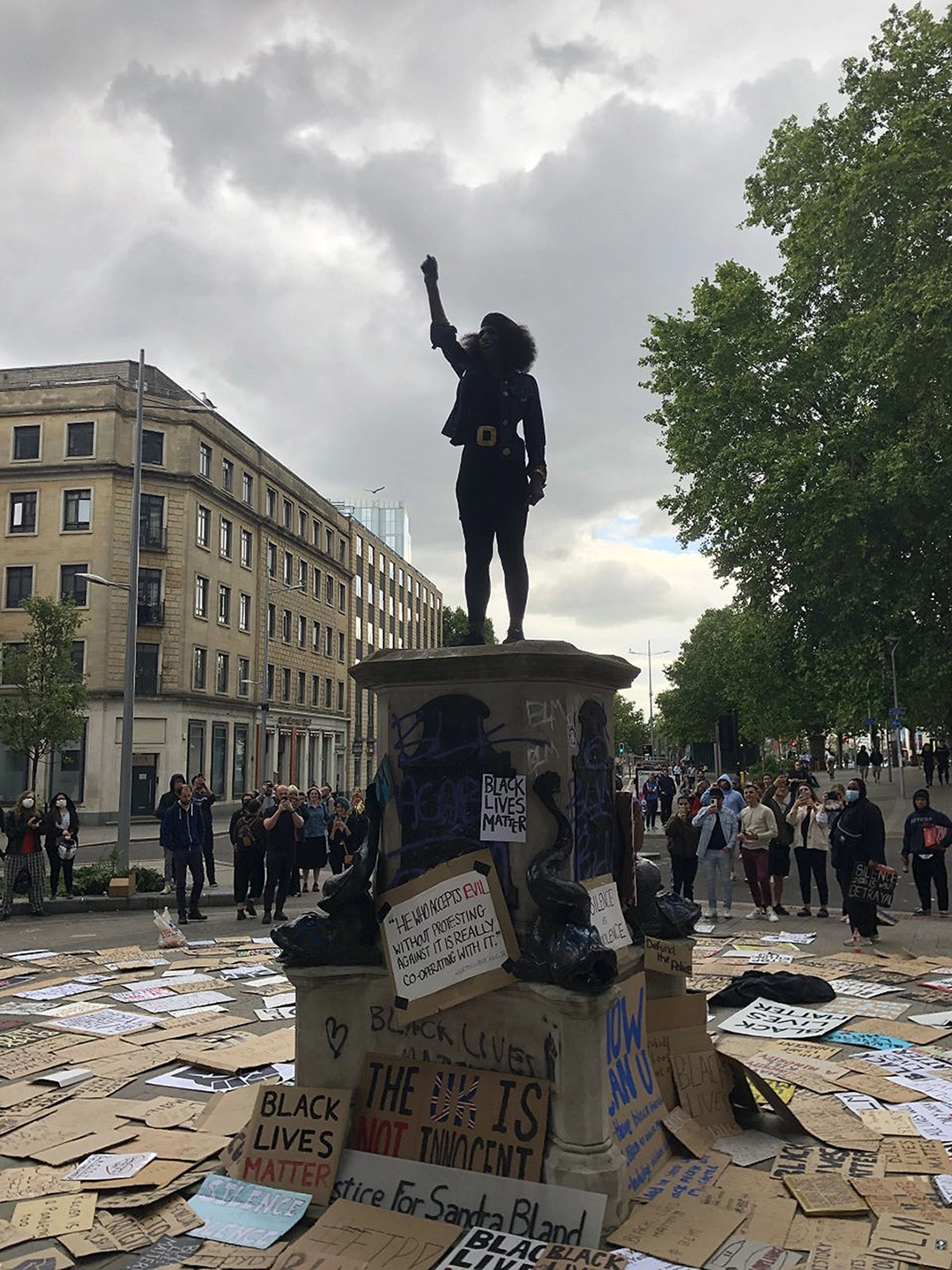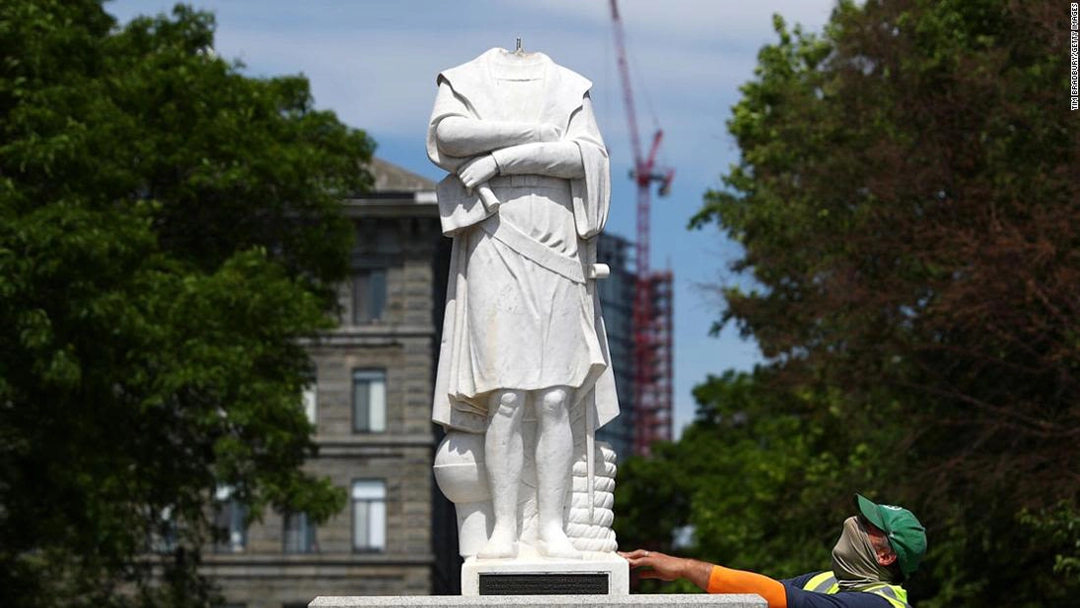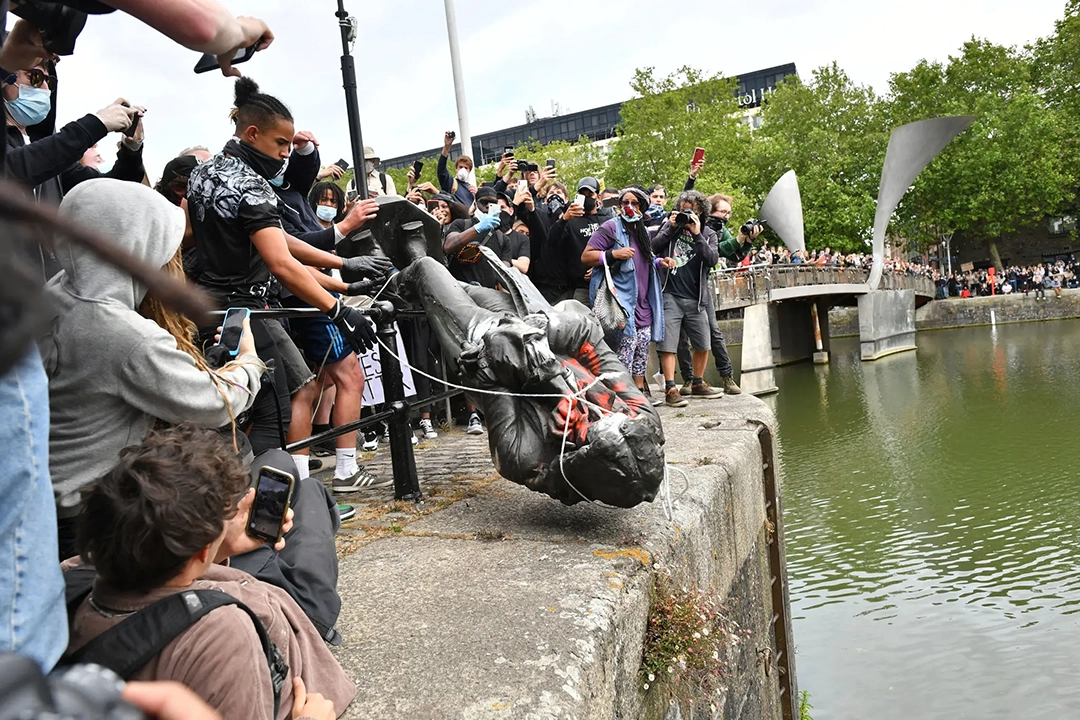
On 8 June 2020 the statue of Edward Colston was dramatically toppled as part of the ‘Black Lives Matter’ movement in Britain. Courtesy of Alasdair Doggart.
I keep in my files an article The New York Times published on June 11, 2020. You’ll recall those were particularly unsettled months. The paper updated it on the 24th, while the protests over the murder of George Floyd in Minneapolis—on May 25, 2020, at the hands of a white police officer—were still echoing. The crime—captured on video and broadcast everywhere—unleashed a global wave of outrage against systemic racism and police violence in the United States. Black Lives Matter reached an unprecedented scale, with daily demonstrations across every major city in the country and solidarity protests in Europe and Hispanic America.

Boston authorities reported an act of vandalism against a statue of Christopher Columbus. The statue’s head was torn off and left at its feet. In several parts of the world, statues of historical figures were vandalized during the protests over the killing of George Floyd.
In that climate of moral and political agitation, statues stopped simply “being” and became tangible symbols of a historical power many were challenging. Those of Confederate generals, colonizers, conquerors, and slave traders seemed to come alive and, with their gazes, to validate a racist legacy and several centuries of exploitation. Down they went—sometimes decapitated—statues of Christopher Columbus, Jefferson Davis, Robert E. Lee, Edward Colston, and even figures of British and Belgian colonial leadership in Europe. Columbus, by far, was toppled most—perhaps because he stood in so many plazas across Hispanic America.
The sound of stone or metal striking pavement became familiar. Each fallen statue felt like an act of poetic justice. A radical tectonic shift in the moral landscape. Although there were two or more sides, it was not the time to weigh heritage or historical patrimony. What was being waged—a struggle that looked large but was in fact rather modest—was a fight for the right to one’s own narrative and to determine what collective memory ought to remember.

A. P. Hill statue—the last Confederate to be taken down from its pedestal in Richmond last December.
Photograph by Lenin Nolly
The article included part of an interview with historian Erin L. Thompson, who thought it relevant to distinguish some destructions from others. One—reprehensible, for instance—was what happened in Palmyra between 2015 and 2017. The extremist group known as the Islamic State (ISIS) occupied the ancient Syrian city—declared a UNESCO World Heritage Site. The jihadists blew up Greco-Roman temples, columns, tombs, and millennia-old sculptures, including the famed Temple of Bel and the Arch of Triumph. They sought to erase every trace of what they deemed idolatry. They also murdered archaeologist Khaled al-Asaad, the site’s custodian, and looted pieces from the local museum to sell on the black market. It was an act of ideological and economic iconoclasm that symbolized a war against the world’s cultural memory.

The statue of Christopher Columbus in the northern Colombian city of Barranquilla was toppled on Monday, June 28, 2021, during another day of protests in the country, the police reported. Colombia’s national police director, General Jorge Luis Vargas, told journalists that this monument—and another in the town of Santander de Quilichao, in the conflict-hit department of Cauca in the southwest—“were attacked by criminals.”
The group that brought down the monument in Barranquilla placed a hood over the statue, looped a rope around its neck, tied on more lines, and pulled until it fell, shouting “¡Colón asesino!”—“Columbus, murderer!”
For her, however, destroying statues of Columbus or of Confederate generals was positive—healing, liberating, restorative… The New York Times—whether for typographic reasons or lack of space—couldn’t fit in more of those stirring, and fully apt, verbs.
It all depends on who interviews whom—or so it seems. In both cases, we are dealing with an assault on the signs of the past. The paradox of iconoclasm is that the imposition of a renewed truth requires the destruction of the one that, until then, remained in force. The historian acknowledges the power of the destructive act but validates it only when it aligns with her values—or with today’s liberal consensus. If the value of memory depends on whoever declares it legitimate, then no image is safe; no past is out of reach of reinterpretation or demolition. This is a hard subject because it brushes close to the raw nerves of what we call Justice. In any case, one must believe that history can be “purified” by removing its monuments.
When I lived in Miami, in Florida, I lamented that the city seemed ablaze with a frenzy of renewal. Floors changed, windows changed, roofs changed; everything looked freshly inaugurated. They even changed the locks every week. Key safes multiplied that opened no door at all. Fortunately, the oldest residents of Coral Gables preferred to keep everything as it was, and there I would feel the weight of the years at every turn.
It would all be very simple if toppling statues were only a political gesture.

Protesters throwing the statue of the slave trader Edward Colston. The New York Times
Destroy or preserve?
Keeping statues that certain groups consider offensive demands too many resources, too much care, and a silence too heavy to sustain. They are highly vulnerable because they were almost always erected in public space and as declarations of permanence—fixing an uncomfortable narrative in time and place. Bringing them down is like dismantling the invisible engineering that held that worldview aloft.
Those who do not wish to preserve them—claiming that space, that pedestal, for their memories, their presence, and other marginalized histories—should also consider the effective rewriting of the shared landscape we must all inhabit. It is not a matter of destroying and going home. That is not a proposition. What is at stake is remembrance, the presence of the past. The moment many monuments are destroyed, they become another reading of history and, from their absence, begin to generate a new discourse.
More than five years have passed since so many statues were wrecked. Were they replaced by others—more fitting ones? No. Many squares remain vacant. The pedestals remain empty. They are the new symbols. There was talk of raising new monuments, but most proposals stalled amid politics, budgets, and fear of controversy. Others chose to install temporary works. Perhaps someone also decided it is not necessary to replace idols with more idols. What I believe is this: it is easier to destroy than to build. A passing enthusiasm suffices to unleash violence on remembrance. To build, you need an enthusiasm that can last.

The image captures the moment the statue of Confederate General Robert E. Lee was removed in Richmond, Virginia, on September 8, 2021. The equestrian statue, erected in 1890, was one of the largest Confederate monuments in the United States. Its removal followed years of protest and a protracted legal battle, as the statue had come to be seen as a symbol of slavery and racial injustice. The decision to remove it was announced by Virginia Governor Ralph Northam amid nationwide protests over the death of George Floyd. The governor described the monument as a “monument to the Confederate insurrection.”
What is beyond dispute is that there is always some good reason to destroy, to vent tensions that almost never have much to do with what is being torn down. Columbus has been dead and buried for four centuries. What does he represent, really? He embodies white, European domination: the founding violence of colonialism; centuries of exploitation, slavery, and genocide against the Indigenous peoples of the Americas; the emblem of a conquest that imposed dispossession and structural racism. Give him a minute of consciousness and he would be astonished at all he stands for today. Of the navigator who wanted pepper and cardamom and sighted land through his spyglass, nothing remains.
The Black Lives Matter mural painted in giant yellow letters on a Washington, D.C., avenue in 2020 no longer exists. It not only became a tourist emblem, an object of aesthetic consumption—I saw it myself in 2021 or 2022—but it shed almost all its political weight. The new reality compelled the city to hush the untimely echo of collective indignation. Gestures of resistance do not escape the logic of the dominant power.
I come from a country that cheerfully set about destroying all the symbols of its past. Near where I lived, the well-known Avenue of the Presidents in Havana’s Vedado district was a gallery of empty pedestals. They toppled almost everyone’s statues—“revolutionarily,” as they liked to say. Then we spent fifty years without free elections, with a single president who clearly foresaw what they would do to his. If anyone understands symbolic battles, it is the Cuban people—today among the poorest on the planet. The Battle of Ideas still goes on there. The dead… are borne only by the Cuban people.
Where did the remains of what was torn down end up?






Comments powered by Talkyard.